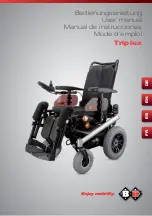
9. MAINTENANCE
Protect your wheelchair by having it checked regularly. We
strongly advise you to have your wheelchair checked at least
once a year by a qualified technician and that only original
spare parts be used. This periodic inspection will ensure you
that the wheelchair will work perfectly for years. There are
a lot of things you can do yourself to keep your wheelchair
in optimal conditions. Regular checks and constant main-
tenance will extend the life of your wheelchair and make it
easier.
9.1. Warranty
Scope of the warranty
You will receive the factory warranty along with the wheel-
chair. However, your dealer may offer a supplementary war-
ranty.
This warranty is only granted to you as the consumer. It is not
intended to be used commercially (for hiring or institutional
use). The warranty is limited to material defects and possible
hidden vices.
The wheelchair is covered by a two-year warranty for materi-
al or manufacturing defects. Excluded from the warranty are
imperfections caused by improper use, accidents or natural
wear of parts such as plastic components like the footrests,
tyres, inner tubes, upholstery, brakes and similar parts.
If you do not follow instructions, warnings and the notes in
the user’s manual, you or a third party may be physically
injured or the product may be damaged and the warranty
may be voided.
g
Tip:
This warranty is not transferrable.
Replaced or repaired parts are covered by the same warranty
conditions as the original wheelchair. Worn parts are normal-
ly not guaranteed, unless these parts are worn as a direct re-
sult of an original manufacturer defect. These parts include
the upholstery, tyres, inner tubes and similar kinds of parts,
for example.
The warranty conditions above describe all wheelchair parts,
and apply to the models bought at the normal end-user price.
1. Not maintaining the wheelchair and parts according to the
manufacturer’s instructions or not using the specific orig-
inal parts;
2. Damaging the wheelchair or parts due to negligence, an
accident or improper use;
3. Adjusting the wheelchair or parts other than as indicated
by the manufacturer or doing any repairs before notifying
the authorised service technician;
4. If the product is not equipped with an original factory
frame number and identification label as described in the
manual, see section 1.
The wheelchair that is described and presented in this manual
may differ from your own model in certain details. However,
all instructions are relevant, independent of slightly different
details. We reserve the right to change the product in this
manual without further notice. All measurements, drawings
and capacities indicated in this manual are approximate and
may be slightly different to your wheelchair specifications.
p
Warnings:
ORLIMAN will not be liable for any consequential or individ-
ual damage whatsoever. While the purpose of this instruc-
tions booklet is to describe proper care, it is not exclusive.
You must consult with an authorised dealer if you plan to
use the wheelchair in any way other than as indicated in this
instructions booklet. If any adjustments are made with struc-
tural repercussions, the warranty will be completed voided
immediately.
g
Tip:
Then, you will also find extensive information on the mainte-
nance of your wheelchair.
Preventive maintenance is most important and many of
these things you can easily do yourself or a friend or family
member can help you. The maintenance you can do yourself
is highlighted below.
p
Every month:
• Check how the wheelchair is folding and whether the
rear wheels are easy to remove;
• Check the upholstery for wear;
• Check front and rear wheel movement and check how
well the wheels turn;
• Check whether the brakes are working correctly;
• Check for any wear on the tread.
p
Every three months:
• Check all bolts, screws and nuts and tighten if neces-
sary;
• Check all spokes for tension;
• Check whether the brakes are working correctly;
We recommend you have the conditions of your wheelchair
checked at your orthopaedic store..
9.2. Wheels
Examine tyres periodically for wear and replace them as
needed.
PU tyres: polyurethane (PU) tyres are most often used for
wheelchairs. They can be recognised as there is no valve. The
advantage to these types of tyres is that they do not need to
be pumped up and cannot be punctured. Just as occurs with
air tyres, polyurethane (PU) tyres can wear out. Periodically
check to ensure the tread is still deep enough.
9.3. Brakes
Inspect both brakes for sharp rims. If there are sharp rims
on the brakes we advise you to replace them. Ensure that all
the parts of the brake are in the right position and secured.
• Make sure that the mechanism is working smoothly. If
it is not working smoothly, apply a few drops of WD40
or Teflon oil to the turning points. Remove any excess
or dirt.
• Make sure the brakes do not come into contact with the
wheels as you are moving.
9.4. Cross frame
The cross frame of the wheelchair has to be in good condi-
tion. The cross frame is the foundation for your wheelchair.
• Make sure the wheelchair can be easily folded and un-
folded.
• Make sure the wheelchair travels in a straight line while
moving.
• Make sure the cross frame is not bent and shows no





































